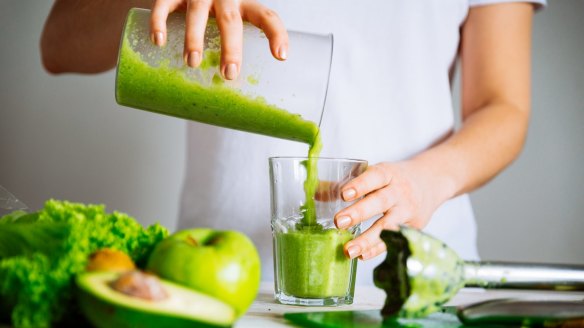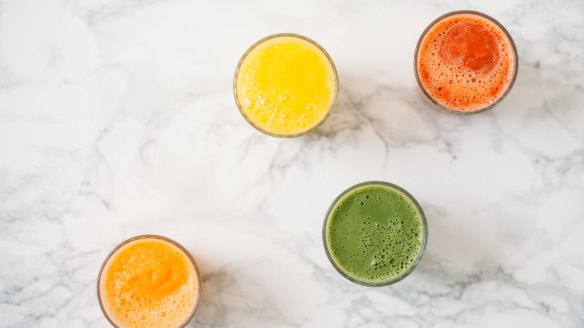How to make juice part of a healthy diet

Juice was pretty simple when I was a kid. My parents gave me apple or orange juice for a boost of vitamin C. Sure, they knew it had sugar, but they mostly worried about that in terms of dental cavities. But now we know there are other important reasons to be concerned about how juice operates as a sugar-conveyance system.
All fruit juice – whether it's apple, orange, grape or a fancy blend such as peach-mango-blueberry – is high in sugar. A 235ml serving of juice and cola both contain about 30 grams of sugar on average – that's almost eight teaspoons. Plus, most commercial juice eliminates wholesome fruit parts such as skin and pulp. And goodbye, fibre. Smoothie blends made from whole fruit may have a gram or two of fibre, but just as much sugar as any other juice. It's better to eat whole fruit instead – to get more fibre and cut down on sugar.
Consider this: You aren't likely to eat three apples in one sitting, but it's easy to drink the equivalent of three apples in one glass of juice. With a sugar avalanche such as that, your body doesn't care where it comes from. Too much is too much, regardless of the source.

Yes, fruit juice contains "natural" sugar – but that does not make it healthier than the sugar in cola. In fact, the World Health Organisation doesn't even classify the sugar in juice as natural sugar. Instead, it's grouped with "free sugars", just like the sugar in soft drink.
WHO recommends adults and children reduce intake of free sugars to less than 10 per cent of total calories. For an adult consuming 8368 kilojoules daily, that's no more than 50 grams (or 12 teaspoons) of free sugars per day from all sources – be it lollies, baked goods, soft drink or juice. It's even less for kids – maybe eight or nine teaspoons. Getting more than 10 per cent of energy from free sugars is linked to an increased risk of cardiovascular disease, stroke, Type 2 diabetes, dental cavities and some types of cancer.
Children consume more juice than any other age group, which is problematic if it displaces other nutritious foods. The American Academy of Pediatrics says it's not necessary to offer children any juice. If you do, it recommends no juice before age 1, then its guidelines state that "the intake of juice should be limited to, at most, 120 millilitres a day in toddlers 1 through 3 years of age, and 120-180 millilitres a day for children 4 through 6 years of age." After age 7, it recommends a maximum of 180 millilitres per day. (I think that's too much and recommend water instead).
Too much [sugar] is too much, regardless of the source.
There is one bright spot: Fruit juice does offer some nutrients. Studies show drinking no more than 150 millilitres a day is linked to a lower risk of heart disease and stroke. So a small amount of fruit juice seems to be OK, but too much sugar from all sources – including juice – is linked to poor health outcomes.
What about commercial vegetable juice? Options such as the traditional savoury tomato-based concoction have just two teaspoons of sugar for 240 millilitres. but a whopping 650 milligrams of sodium. That's not a nutritious swap for fruit juice.
More recently, vegetable juice has been reinvented to include a nutritious array of cold-pressed elixirs that are low in sugar and have no added salt. Celery-parsley tonic, anyone? People are investing in cold-press masticating juicers for their home kitchens, and juice bars are popping up across the country, offering an array of single-serve bottles in the $10 range.
Is it nutritious to sip a beverage made from low-sugar leafy greens, celery, cucumber and ginger? Sure, if you can afford to. For relatively few kilojoules and less than a teaspoon of sugar per cup, you get a variety of vitamins, minerals and antioxidants in a hydrating beverage. It's a good option for people who struggle to eat enough vegetables, and it's definitely a better choice than sugary fruit juice. Just watch out for high-sugar vegetables as ingredients (carrots, sweet potatoes, beetroot) or vegetable juice blended with fruit for palatability.
Cold-pressed juices are said to be more nourishing than traditional commercial juices from concentrate because they undergo less processing and are not heat-pasteurised, meaning they retain more nutrients. I haven't seen any clinical studies ably comparing the nutritional benefits of cold-pressed versus juice from concentrate, so exact measures are not available.
A note of caution: Excessive juice consumption can pose special dangers to people who are on blood thinners or have kidney disease, because high intakes of certain vitamins and minerals may interfere with medical conditions. Speak to your doctor before consuming a lot of juice, no matter what kind.
Finally, regardless of which juice you choose, ignore the marketing hype. Juice will not detox your body, boost your immune system or cure cancer. There's no scientific evidence that juice is any better than eating fruit or vegetables. Though a bit of juice can be part of a healthy diet, you can save money and time in the kitchen – and reduce the risk of consuming too much sugar – by simply eating fruits and vegetables instead.
Cara Rosenbloom is a registered dietitian.
The Washington Post
The best recipes from Australia's leading chefs straight to your inbox.
Sign up- More:
- Health and nutrition